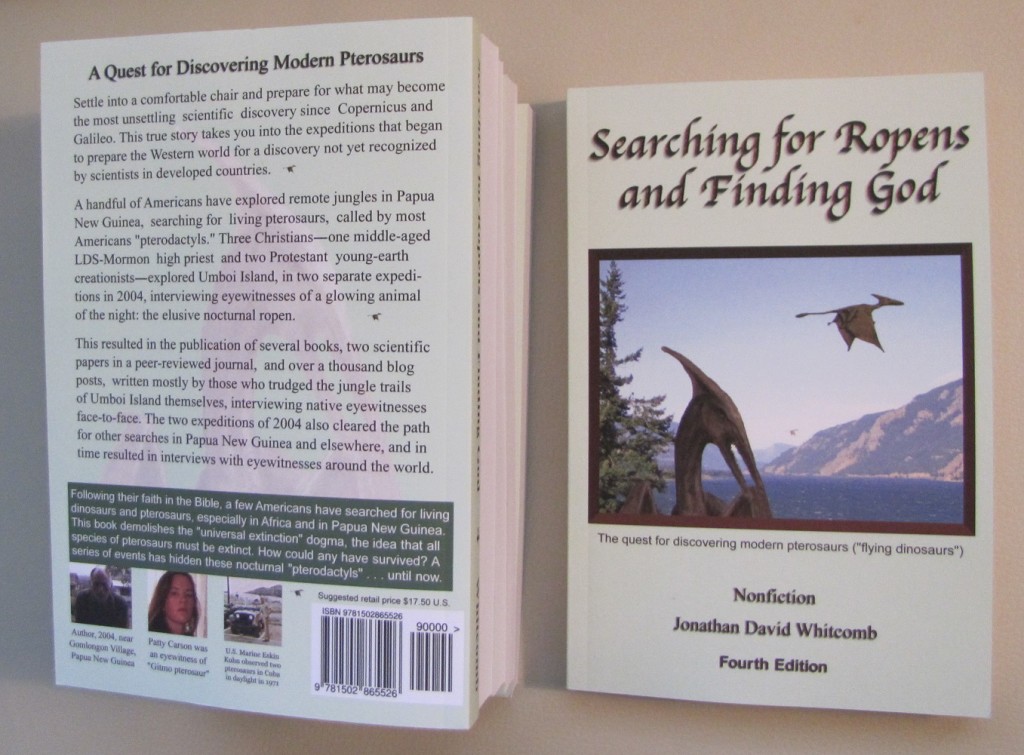How can intelligent people believe that pterosaurs, those “primitive” flying creatures called pterodactyls, might still be flying over our heads? How can anyone believe in something so incredible? A terse rejecting of all the possibilities of a modern species of “flying dinosaur,” however, is answered thus: How do you explain all the eyewitness testimonies?
Cryptozoology and Science
The following is taken from the short nonfiction e-book Live Pterosaurs in Australia and in Papua New Guinea, by me, Jonathan D. Whitcomb.
Common persons in the southwest Pacific have seen something big flying overhead, something uncommon, unlike any bird or bat.
My American associates and I have explored remote jungles in Papua New Guinea, searching for living pterosaurs and interviewing native eyewitnesses. Most expeditions were led by one or two Americans, with one or two native interpreters. Did we fail or succeed? It depends on who interprets our investigations: skeptics who point out the lack of an official scientific discovery or open-minded cryptozoologists who recognize progress and hope it will continue.
Cryptozoology is not a branch of science, at least not in the usual sense; but it can motivate zoologists to conduct field investigations, at least in theory it can motivate them. It is the “study of hidden animals,” and usually relies less on direct scientific examination and more on eyewitness testimony; nevertheless, we can use scientific reasoning and methods within the boundaries of cryptozoology.
The American missionary Thomas Savage, in the 1800’s in Africa, obtained some bones of what we now call a “Western Gorilla,” which prepared for its eventual scientific acknowledgement. Whatever led that missionary to obtain those bones can be called “cryptozoological,” especially if he had been following eyewitness accounts.
The following is taken from the introduction in my larger book, Searching for Ropens and Finding God (fourth edition):
Although I encountered no dragon during my brief stay on Umboi Island in 2004, eyewitnesses I did encounter, objective witnesses of the reality of the ropen, with no superstitious native traditions tainting testimonies, almost without exception. Islanders of Umboi see the ropen and report what they saw; why should they doubt their own senses? And why should we doubt natives? Human experience lives at the foundation of all human societies and at the foundation of science; why single out experiences of those of another society as unreliable? Defending traditions of our own culture may be the worst excuse for rejecting experiences of natives who have long been labeled “primitive.”
To elaborate on the foundation of science being human experience, what do most Americans and other Westerners mean by “scientific?” Some non-scientists use that word as if it referred to some huge collection of statements of fact. Some of them use scientific to dismiss any and all eyewitness accounts of anything that may suggest an extant pterosaur. In reality, Western science was born with eyes that could see and a mind that could reason on what it perceived. Galileo and other early European scientists worked on understanding what they experienced, including what they saw with their eyes. Imagination is important, but the greatest scientists accepted human experience as the great validator of what they imagined.
Dr. Donald Prothero the Paleontologist
A few weeks ago, an American paleontologist, Donald Prothero, wrote a blog post, “Fake Pterosaurs and Sock Puppets,” in which the word fossil was absent. Please note, paleontologists are experts in fossils; it’s hard to find a dictionary definition of paleontology without noticing the word fossil. That was a strange omission.
“Fake Pterosaurs and Sock Puppets” was that professor’s opinion about my integrity, in particular my honesty, for he used the word deception regarding my online publications. That smells of bulverism, if not outright libel. I suggest that the bad motivations on my part were only in his imagination and in what was imagined by a few previous writers that had influenced him.
Outside the comments at the bottom of Prothero’s post, the word eyewitness is absent. That was a strange omission, for I am a cryptozoologist, an investigator who specializes in eyewitness testimonies. Why did he neglect getting into any details about his specialty and about my specialty?
Dr. Prothero may be a highly acclaimed paleontologist in the United States, or perhaps around the world, in his areas of expertise with fossils. But he seems to have completely failed to research what was outside his area of education and scientific credentials: the narrow branch of cryptozoology involving reports of apparent living pterosaurs.
Credibility of Eyewitness Testimony
The statistics from 128 of the more-credible reports, compiled at the end of 2012, prove that no significant number of hoaxes could have been involved. Prothero says nothing about that in his post about me. He does not even hint that any analysis was ever done on any eyewitness reports.
Detailed study shows certain critical descriptions in reports from around the world, reports that I have received over the past eleven years from four continents. Prothero gives not even a hint that I have ever received any reports directly from eyewitnesses. He was concentrating on making it appear like the subject of modern pterosaurs is not worth thinking about because it is all “fake,” and practically all of the publications are from me, and I am not to be trusted because I acted improperly in the use of “sock puppets.”
I suggest that the truth is better known and understood by following the evidence, not by following dead-end trails of bulverism.
###
.
American paleontologist “attacks” living pterosaurs
Readers of a recent post by Dr. Donald Prothero may think that I, Jonathan Whitcomb, have single-handedly deceived ignorant people into believing that pterosaurs are still alive. The paleontologist seems upset that my web pages dominate Google searches.
Clear Thinking and Donald Prothero
. . . using the word deception three times regarding me, Jonathan Whitcomb. . . . C. S. Lewis gave us “bulverism,” lamenting the decline of human reasoning. He defined the word in the mid-twentieth century: “The modern method is to assume without discussion that he [someone whose opinion you dislike] is wrong and then distract his attention from this (the only real issue) by busily explaining how he became so silly.” How much better to talk about the subject at hand!
So here I am, a very convinced “Evolutionist” who has written a great deal on Darwin, Chambers, Russel Wallace etc reading a book on Live Pterosaur sightings by an out loud and proud Creationist. And you know what? It really makes no difference to the case. So Whitcomb believes in living pterosaurs? The sceptics who attack his research are equally convinced they are extinct. It’s an issue it is rather hard to maintain a strict impartiality on.
.
Another book on living pterosaurs:
Fourth Edition of what could be called “The Bible of Modern Pterosaurs,” by Jonathan David Whitcomb, but the actual title is Searching for Ropens and Finding God
.



